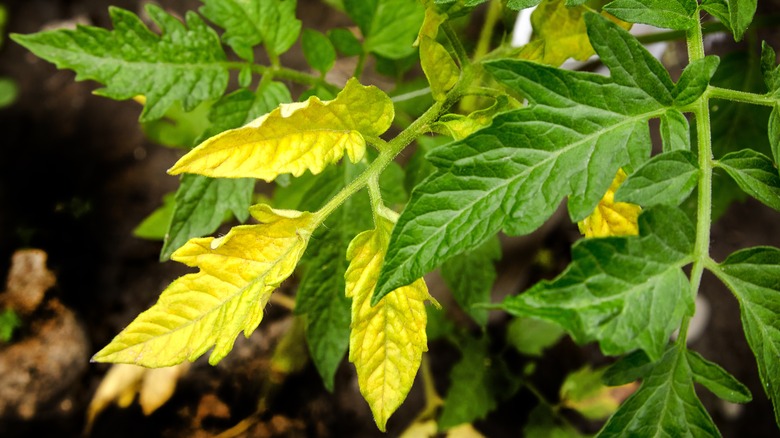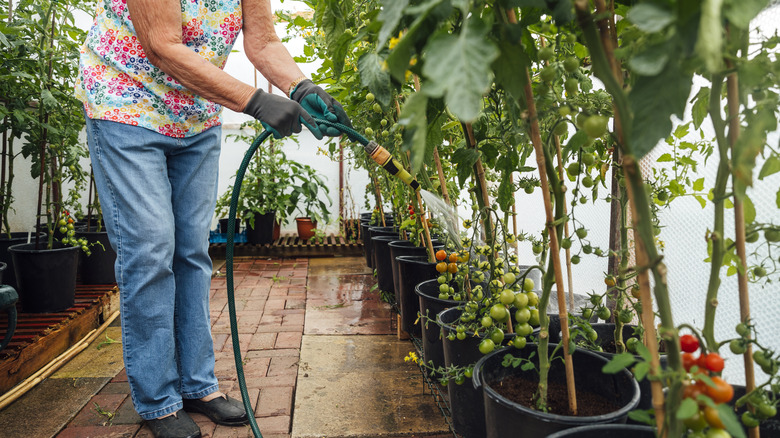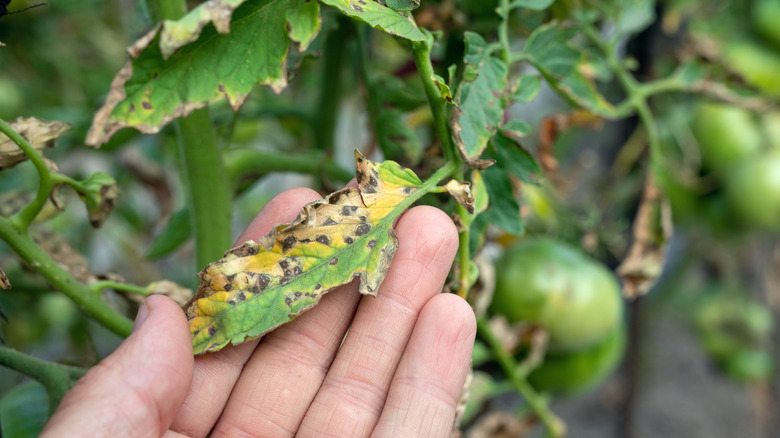Faced With Yellowing Tomato Leaves? Here's Why That Is Happening
Ugh, the leaves on your tomato plants are turning yellow. Did you make the mistake of planting them too early or too close together? Or is the leaf discoloration a sign of a more serious issue? Don't panic. Yellowing tomato leaves are a common problem faced by both beginner and experienced gardeners. The abnormal coloring of the leaves may be caused by a variety of factors, including nutritional deficiencies, water issues, diseases, or pests. Fortunately, with a little troubleshooting, you can get to the root of the problem and apply the appropriate solution to restore your tomato leaves to their original vibrant green glory.
To identify the source of yellowing tomato leaves, start by examining the entire plant. It's no secret that the best tomatoes are born from strong root growth, so don't ignore what's under tomato foliage. Typically, you don't have to dig deep to uncover the extent of leaf discoloration. If you notice just a hint of yellow on the plant's bottom leaves, you may not have a problem at all.
These seedling leaves will eventually fall off on their own. Moreover, slight discoloration is a standard issue seen with nursery-grown tomato plants that were confined to small pots and jammed next to taller neighboring vegetation, reducing adequate exposure to sunlight. Lack of sunshine on lower leaves can cause benign yellowing. There's more cause for concern if the leaves above them are yellow.
How to identify and fix nutritional deficiencies and water issues
If the leaves on your established tomato plants are yellowing, generally the issue is a nutritional imbalance. Healthy tomato plants require a lot of nutrients to bear good fruit, which is why it's critical that your soil is sound. If it's lacking nitrogen, iron, magnesium, or potassium, you'll see it in your tomato plant's leaves. Nitrogen deficiency is the easiest to spot as the entire leaf will be yellow.
Meanwhile, an iron deficiency generally presents in young leaves that appear yellow with green veins. Tomato plants lacking magnesium can be seen on older foliage with yellow spots or blotches, while those in need of potassium will feature new leaves with yellowing around the edges. Frequently applying nutrient-rich fertilizer will alleviate most mineral deficiencies. However, to fix magnesium insufficiencies, combine 2 tablespoons of Epsom salt with a gallon of water to create a DIY solution that can be sprayed directly on the plant.
Properly watering tomato plants is vital in preventing leaf discoloration. Too much or too little hydration can cause a leaf to yellow. On average, tomato plants need about an inch of water per week during the early part of the growing season and two inches per week once they develop fruit. You can conduct a soil moisture test by tunneling your finger several inches in the soil. If it feels dry, the plant needs water. To avoid overwatering, consider drip irrigation where water is applied directly to the roots.
Tips to identify and fix tomato plant diseases and pest problems
Tomato plants are vulnerable to a variety of diseases that cause leaf discoloration — bacterial and fungal infections are the most common. Diseases like tomato blight and bacterial wilt attack the plant's vascular system, preventing water and nutrients from getting to the leaves, which results in yellowing, wilting, and eventually death. To stop diseases from spreading, remove all dead or infected leaves from the tomato plant. Next, treat the plant with fungicide and consider crop rotation.
Another preventative measure to ward off diseases, such as tomato blight is to leave about 3 feet of space between each tomato plant to increase air circulation and expedite water absorption. Likewise, adding 2 to 3 inches of mulch around the base of tomato plants will also help reduce excess water intake and decrease fungal spore splash dispersal.
Finally, abnormal yellowing of tomato plant leaves could be a sign of pest infestation with mites and aphids being the most common culprits. Spotting this nuisance is usually easier than discerning diseases as the plant's leaves will not only appear yellow, but they will also feature curled tips. If you recognize symptoms of an aphid invasion, consider eco-friendly repellents.
Aphids detest nasturtiums, marigolds, garlic, and chives. Adding these companion plants to your garden in close proximity to your tomato crops will not only act as an effective aphid deterrent, it also promotes healthy soil and increases weed suppression.


